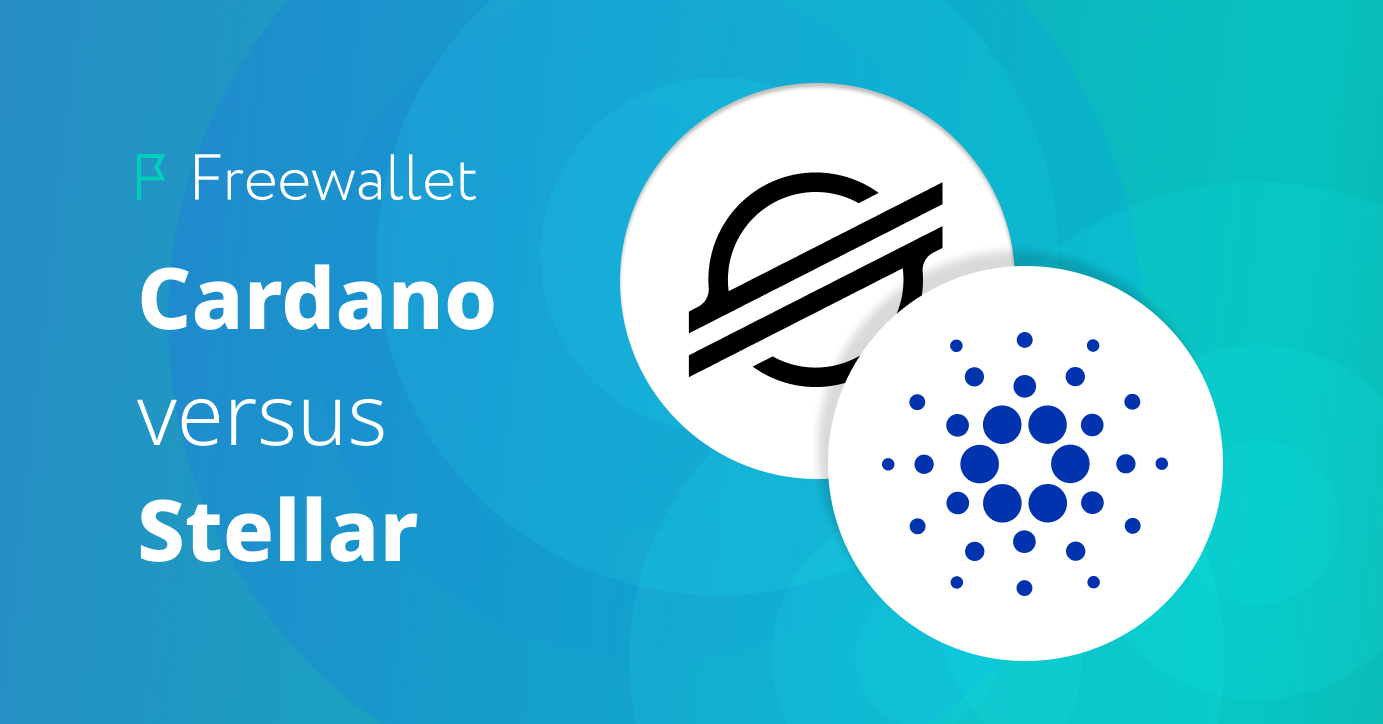
Cardano vs. Stellar: comparing these two top crypto projects is useful to better understand their goal to create a more inclusive economy.
In this ADA vs. XLM comparison article, we will highlight the main features of both projects: when and why they were born, who their founders are, what are the main purposes of the projects behind these cryptocurrencies.
We will also carefully analyze the distinctions between the two: they are two of the most appreciated projects in the crypto space, but they are among the first cryptocurrencies by market capitalization for different reasons.
Cardano Vs. Stellar Lumens: some parameters to distinguish the two projects
| Cardano (ADA) | Stellar (XLM) | |
| Foundation date | 2015 | 2014 |
| Founders | Charles Hoskinson | Jed McCaleb & Joyce Kim |
| Supply | Limited. Max supply: 45,000,000,000 ADA | Limited. Max supply: 50,001,806,812 XLM |
| Consensus | Proof-of-Stake | Stellar Consensus Protocol (SCP) |
| Blockchain | Cardano | Stellar |
| Main purpose | DApps | Transactions |
| Smart contracts | Yes | Yes |
| Latency | 20 seconds | 3 – 5 seconds |
| Transaction cost | 0.16 ADA | 0.00001 XLM |
| Staking | Yes | Yes |
What is Cardano (ADA)
Cardano is a crypto project aimed at bringing new and sustainable technologies to end users globally.
Even if its approach is extremely scientific and based on professionals who autonomously created and reviewed the blockchain, they want to provide simple outcomes, in order to allow anyone to be a part of the modern economy created thanks to blockchain technology.
After Charles Hoskinson announced that Cardano would launch smart contracts, traders, investors, and developers really perceived the intention of Cardano to improve the current economic system by further facilitating the creation of smart contracts and the possibility of more use cases.
What is Stellar (XLM)
Also Stellar focuses on global opportunities for anyone, but its focus is on transactions: as we can read on Stellar official website, the project wants to create all existing forms of money in a digital way.
What the project is able to do is to allow people to make transactions with different currencies and across different countries, all thanks to its cryptocurrency — XLM.
This project wants to improve the current financial system, especially by giving more opportunities to unbanked people.
For these reasons, Stellar was designed to be inexpensive and fast.
What are the main differences between Cardano and Stellar?
By analyzing all the parameters we mentioned earlier in more detail, it’s easy to assess that even if Cardano and Stellar have many similarities – like reliability, rewards, previous experiences of the founders in the crypto space, differences are what make these two projects unique and focused on different goals.
In this Cardano vs Stellar Lumens article, we will highlight all the main differences – but also some analogies – between the two projects.
Foundation Date
Usually, traders and investors consider the foundation date as a synonym of trust: the older the project, the more reliable it is.
Stellar (XLM) was founded in 2014, while Cardano (ADA) was founded in 2015, and the crypto launched in 2017: in the crypto space, this can’t be considered a short time, since the market is fast and hundreds of cryptos are launched every day. Moreover, the two projects proved to be reliable.
Founders
When considering Stellar and Cardano, knowing the founders of the two projects is useful to better understand the design of both XLM and ADA.
Charles Hoskinson is one of the co-founders of Ethereum: involved in the crypto market since 2011, Hoskinson actually created a blockchain more flexible and faster than Ethereum, also taking into account the importance of sustainability in the crypto space.
Jed McCaleb and Joyce Kim founded XLM in 2014. McCaleb in particular worked at Ripple before founding Stellar: after leaving the company, McCaleb co-founded a new project that has many similarities with Ripple but having in mind a more open market.
Supply
Both ADA and XLM have a maximum supply: this is usually considered a pro by traders and investors because a finite supply helps to better control inflation and increase the value of the cryptocurrency of the project.
Consensus
This is one of the main differences we want to analyze in this ADA vs. XLM comparison.
Cardano uses a Proof-of-Stake consensus algorithm: POW usually makes blockchains faster, more secure, and scalable, incentivizes nodes, and privileges sustainability. Each transaction is confirmed by several nodes in a decentralized system.
Stellar created a particular consensus mechanism, the Stellar Consensus Protocol (SCP).
The SCP is a form of federated Byzantine agreement system where the process is more flexible because the protocol manages to adapt to an ever-changing ecosystem, able to verify a quorum even if nodes leave and join the system.
Blockchain
Both projects have built independent public blockchains.
Main Purpose
The two projects differ also in their purposes.
While Cardano is mainly focused on creating a sustainable ecosystem to allow developers to create decentralized applications thanks to smart contracts, Stellar is focused on simplifying cross-border transactions.
The main goal of Cardano is to improve the path born with Ethereum, towards a decentralized and more inclusive economy. Also Stellar wants to onboard as many people as possible, focusing on the end-user, but it does that by simplifying transactions among different currencies and countries.
Smart Contracts
As mentioned, Cardano is developing a less expensive and more sustainable environment for developers than Ethereum, and smart contracts have a key role.
On the contrary, even if Stellar supports smart contracts, they are limited in scope since they mainly allow transactions.
Latency
Latency is defined as the time needed for a transaction to be complete — that is, from the time a user makes a transaction to the moment it actually occurs.
As highlighted in the first comparison table of Cardano vs Stellar, Stellar has a lower latency if compared to Cardano.
Transaction Cost
Another difference between Cardano and Stellar is that the latter allows more inexpensive transactions in terms of fees.
Staking
Both projects reward nodes for staking their native cryptocurrencies — ADA and XLM. This makes the projects more sustainable, decentralized, and secure. But differently from ADA, staking XLM is more difficult because not many platforms support XLM staking.
Pros and Cons of Cardano and Stellar: Comparison Table
| Pros | Cons | |
| Cardano | – Strong project: the team behind Cardano carefully considers the right times to make upgrades and improve the blockchain – Smart contracts support – Limited supply – Staking available | Higher latency and transaction costs if compared to Stellar |
| Stellar | – Particular and efficient consensus mechanism – Lower latency and transaction costs if compared to Cardano – Smart contracts support is planned – Staking available – Max supply set | – Stellar Smart Contracts have a limited scope if compared to Cardano – It’s harder to stake XLM than Cardano |
How to buy and store Stellar on Freewallet
Buying and storing Stellar (XLM) on Freewallet is easy. At the time of writing, Cardano is not supported by Freewallet.
If you want to use this wallet, fully optimized for mobile devices and with its application supported by Android and iOs systems, the first step is to sign up: users can easily create an account also via social media.
After creating an account, you will have access to your personal dashboard.
Users can choose to buy cryptocurrencies on Freewallet with a credit card:
- Choose the cryptocurrency you want to buy;
- Add the amount;
- Decide the currency you want to use to pay;
- Add your address;
- Complete the transaction.
From your dashboard you can also choose to import more wallets, to manage your crypto funds from the same platform.
Moreover, transactions among Freewallet users are free.
Conclusion
Both Stellar Lumens and Cardano are strong crypto projects created to improve and modify the current economic and financial system to make it more inclusive.
While Cardano is more suitable for crypto users who want easy-to-stake crypto and who want to profit from the decentralized economy, Stellar is suitable for those who use cryptos mainly to make transactions.
Both have their roles in the crypto space, and both want to make cryptocurrencies even more popular and reliable.
Related
Stay tuned
Subscribe for weekly updates from our blog. Promise you will not get emails any more often.
Most Popular
New Posts
Stay tuned
Subscribe for weekly updates from our blog. Promise you will not get emails any more often.





